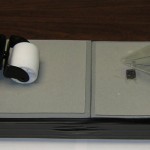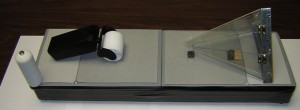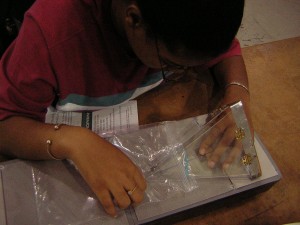Designers: Uranie (Peppi) Browne, Dorian Miller
Client Coordinators: Ashley Stone and Gena Brown, Goodwill Industries of Eastern North Carolina, Inc.
INTRODUCTION
Goodwill Industries of Eastern North Carolina provides vocational training for high school students with disabilities. The work training regimen includes performing repetitive tasks, and the students are paid for each completed task. One of their tasks is to fill Ziploc bags with a user manual, a set of keys and three spare screws. This is a difficult task for any individual, since the bag is just barely large enough to hold the enclosed manual. However, it is particularly difficult for those students with disabilities who have limited function in one hand. The goal of the project was to create a device that would assist them in filling items into a Ziploc bag. A modular universal device called JAWS was designed so that it could benefit every student at Goodwill. However, the design focused on the needs of two students, one with impaired cognition and the other with cerebral palsy. Both of them have limited function in one hand.
SUMMARY OF IMPACT
The clients can successfully use JAWS to fill Ziploc bags with a four page manual, three screws, and a pair of keys. JAWS made this task much easier to accomplish because it holds the bag in place, keeps it open, and provides a clear path for inserting the manual into the bag. Gena Brown, a supervisor at Goodwill, says, “I believe that JAWS will increase the productivity of our interns, level the playing field with their faster peers, so to speak, decrease the level of frustration that they feel as they work on this kind of job, while increasing their sense of accomplishment. Additionally, it will give them the opportunity to try jobs that they may not have been able to do before, while decreasing the possibility of damaging product materials.” Other supported employment centers also expressed interest in using the JAWS device to complete the bag-filling tasks.
TECHNICAL DESCRIPTION
The main component of the device is the metal and plastic pyramid, which is on its side (shown on the right side of Figure 1). The user places the Ziploc bag over the peak of the pyramid (see Figure 2), and inserts items through the opening on the opposite end. The sides of the pyramid are hinged to a metal frame that surrounds the opening, allowing the peak to open wide like a set of jaws, so that items can pass through the pyramid into the bag.
The metal frame is also hinged to the base of the JAWS device. This allows the peak of the pyramid to be raised and lowered relative to the base. The user raises the pyramid before placing the bag over the peak. Then, the user lowers the pyramid before loading items in the bag; in this case, the pyramid presses down firmly against the bag and prevents it from sliding. A magnetic touch latch, typically used for opening cabinet doors, was used to move the pyramid between the two positions. When the latch is pressed, it alternately extends and retracts by approximately ½”. It is located in the base of the JAWS device, below the pyramid (seen in black, directly below the center of the pyramid in figure 1). To raise and lower the pyramid, the clients simply press down on the pyramid to engage the touch latch below it.
The perimeter of the pyramid consists of three plastic isosceles triangular surfaces (6”x7”) and one 6” equilateral triangular opening through which items are inserted into the bag. Within the triangle is a transparent film that guides items as they are inserted. This curls the manual as it passes through the opening, and the manual will flatten properly in the Ziploc when the bag is removed from JAWS.
The base of JAWS is made from wood, with a surface of stiff foam that includes an embedded metallic layer. This foam is an existing product that is commercially used to post messages with a magnet. A magnet is embedded in the acrylic, near the peak of the pyramid, to provide a strong force between the pyramid and the base. This helps to prevent slippage of the Ziploc bag during filling.
Finally, there is a separate roller with handle that is used to close the seal of the bag. The roller is made from a bad frame caster, with a custom, ergonomic handle made of wood.
The cost of the project is approximately $150.





One Comment
We developed an updated version of this device in spring 2010. It’s called the “Time Card Packaging System”. The project description includes a video.
http://www.bme.unc.edu/~rlg/rehabDesign/?projects=time-card-packaging-system-2